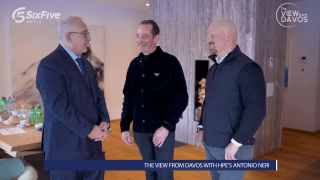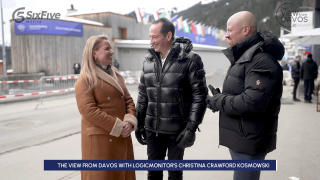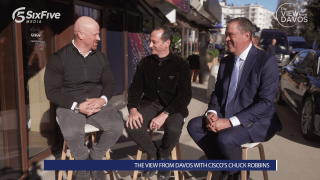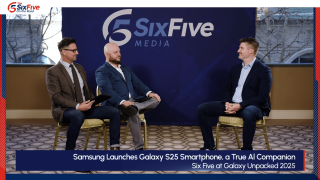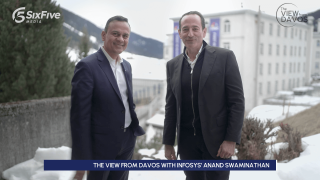AI PC Insights and Strategies for CIOs! Join the Six Five On the Road for part three of our four-part series with Intel. Patrick Moorhead and Daniel Newman are joined by Intel’s Todd Lewellen, VP & GM of PC Ecosystem, and Insight’s Megan Amdahl, COO of North America for an in-depth look at how CIOs should navigate the emergence and integration of AI PCs within their organizations.
This insightful discussion reveals the anticipated benefits, preparation strategies, and the balancing act between innovation and security that accompanies the adoption of AI PCs. Their conversation covers:
- The benefits Insight expects from the adoption of AI PCs
- Intel’s support strategies for enterprises preparing for AI PC integration
- Insight’s plans for merging AI PCs and software into their existing IT ecosystems
- Addressing AI-specific privacy and security concerns with AI PCs
- Strategies CIOs are employing to analyze costs and benefits for AI PC implementation
Learn more at Intel and Insight.
Watch the video below, and be sure to subscribe to our YouTube channel, so you never miss an episode.
Or listen to the audio here:
Disclaimer: Six Five On The Road is for information and entertainment purposes only. Over the course of this webcast, we may talk about companies that are publicly traded and we may even reference that fact and their equity share price, but please do not take anything that we say as a recommendation about what you should do with your investment dollars. We are not investment advisors, and we ask that you do not treat us as such.
Transcript:
Patrick Moorhead: The Six Five is On the Road here at Intel Corporate Headquarters here in Silicon Valley. And Dan, we are talking about our favorite topic, and that is AI.
Daniel Newman: Did you want me to finish your sentence?
Patrick Moorhead: Please.
Daniel Newman: I thought you were lining me up, because I was going to say artificial intelligence.
Patrick Moorhead: There we go. You nailed it there. But it’s amazing how the conversation from, again, I’m going to steal a little what you say, which is AI is not actually new. It’s based on algorithms that are 40 years old. But this latest wave of generative AI has really brought excitement to everybody, not just the tech community, but also the business community as well.
Daniel Newman: Yeah, I mean, the next wave is all about value. Companies are trying to figure out how to implement this technology, how to derive value, how to measure, create ROI. This has become a board-level imperative. Most companies, almost all companies now have a board-level imperative. That means CEOs are thinking about it, CFOs are thinking about it, COOs are thinking about it. And of course our friends in the Chief Information Office are thinking quite a bit about it as well.
Patrick Moorhead: That’s right. They have a lot of things to think about and contend with. And this first wave kind of kicked off in the data center. But what has happened, and this is very natural in all technology inflection points, it moves from the data center to the endpoint. And AI PCs are some of the most exciting, awesome things to come out in terms of their potential, delivering real time incremental value to workers out there for efficiency, and even the potential to drive top-line revenue. And that is one of the big things on the CIO agenda is how do I implement … What kind of strategy do I need to have? And I have Todd from Intel, and Megan from Insight to have this conversation. Welcome to the Six Five.
Megan Amdahl: Thank you so much for having us.
Todd Lewellen: Yeah, thanks for having us.
Patrick Moorhead: Yeah, you heard my preamble. I think I saw a little nodding out of the corner of my eye.
Daniel Newman: Well, they’re sitting right here. They had to listen to you.
Megan Amdahl: We’re kind of in alignment.
Todd Lewellen: That’s right. That’s right.
Patrick Moorhead: Yeah. It is a captive audience for sure. And so as you’re listening, hope you were sort of feeling what we’re saying here, but what we really want to do is sort of expand on these thoughts. Look, the CIO is in a really interesting juxtaposition right now. It went from sort of a period where they were very cost-conscious, how to be most efficient delivering IT that kept businesses running to, oh my gosh, IT is the business. Sometimes you hear things like every company is a tech company. And while we can debate how true that is or is not, what we do know is tech is the exponential driver. It’s deflationary in terms of helping companies scale, and it’s exponential in terms of helping companies drive more productivity. Megan, I’m curious though because we want to focus here on the PC, on the device. At Insight, you’re very, very focused on helping deliver value to many enterprises all over the world. How are you thinking, and how are your clients thinking about this AI PC wave? And what do they think they’re going to gain as they make this transition?
Megan Amdahl: The thing that we’re really helping are clients think through is the AI PC is not going to be uniform for everyone within a company. So we’re taking very much a persona based approach to testing the AI PCs in our own environment first. At Insight, we like to be client zero so that we can really come to our clients and say, “Hey, we looked at it in a way we would expect you to.” By persona, these are the departments that could be using it. This is the type of work that they perform, and this is a value or this is the distraction that we saw them incur.
And when we run into impediments to adoption, we really help them think about this is how we got through it. So insights all in on AI. And to your point earlier, Pat, it’s just a point of things go from the cloud to the edge, and back and forth. And so we see the adoption of the AI PC to be that edge component that we’re here to help our clients adopt and get the maximum ROI. But we don’t think it’s universal, so we think it’s very specific to the role that a teammate has within their organization.
Daniel Newman: And just to put maybe a fine point in there, it can be like creatives, it could be financial experts.
Megan Amdahl: Absolutely.
Daniel Newman: Human resources, are these the personas that you’re talking about?
Megan Amdahl: Yeah. And the one thing that we’re excited about is I think everybody leaned in mostly on the productivity gains associated with it, which we know is going to be awesome, but we’re more interested in some of the transformational things like the revenue growth opportunities, the client affinity. That they’re just going to be obsessed with your brand because they feel so close to it. So those are the use cases that we’re kind of maximizing as a priority for our own organization, and we hope our clients do as well.
Daniel Newman: Yeah, I think we can all agree that enterprises have 50,000, 100,000 fleets that need to roll out. They’re more conservative obviously than consumers, and even small businesses. So there’s a lot of education that has to go in to not only capture the opportunity, the upside, but also de-risk on the other side. And I know Intel has played a role in this education for enterprises for as long as I’ve been in the industry. And I’m just curious how is Intel specifically doing this? Educating, getting the beaches ready for everybody to come on for AI PCs?
Todd Lewellen: Yeah, I think first of all, it’s really building awareness with our OEM partners around just what an AI PC can do. And in some respects it’s kind of simple in terms of you’ve now got three engines. You’ve got A CPU, GPU, and an NPU. You’ve all this compute capability, all this AI inferencing at your fingertips that you didn’t have before. We’ve got content creators that are using all three engines in parallel to do things much faster. We’ve got collaboration apps where you’re moving things like background segmentation off of the CPU onto the NPU, saving over a wad of power, so more battery life.
Daniel Newman: Right. Yeah.
Todd Lewellen: But then you’ve got security ISVs that are saying, “Hey, you know what? I can take that malware detection, I can run that locally on the NPU, not have the round trip from the device to the cloud and back.” It’s lower latency, lower cost. And then we’re seeing manageability partners that are also moving their workloads from the cloud to the client. So there’s just a tremendous opportunity now. It’s funny because we always worried about the cloud and thin clients, and everything’s moving to the cloud. Now we’re seeing the ISVs actually looking at their business model. Where can we save costs? What can we move to run locally?
Patrick Moorhead: A hundred percent. The more that’s done on the local device … And it is funny, I always like to look at the industry trends as kind of like an accordion. It comes out and then it comes back in, but ultimately processing finds the right place, and invariably it is closest to the data as it can be. And I’m seeing that transition as well.
Daniel Newman: Yeah, there’s a lot of work to be done about workload, workload placement, and of course there’s these kind of broader thoughts right now about power, sustainability. So if we can do something efficiently, do it local, avoid that extra sort of egress, and tax, and power utilization, companies are thinking about it. They’ve got accountability to their sustainability. Plus they got accountability to being really intelligent, and of course fiduciary to the bottom line of their companies. Like, “Hey, if I don’t need to do that, don’t do that.” Cloud sprawl is a real thing.
And of course it’s great when we see the industry grow. It’s great when we see the cloud grow. It’s great when we see data center investment being made, but businesses are investing in tech to solve business problems, and so it has to be an enabler. Speaking of an enabler, so as you’re sort of thinking about the AI PC being integrated into these IT environments, what’s your vision for that? I heard you talk about experiences and value. Are you seeing it happen quickly? Are you seeing it sort of happen on a gradual scale?
Megan Amdahl: What’s interesting is we’ve seen the AI PCs be adopted fastest in the consumer space, which makes sense because the enterprise obviously is having to do a significant amount of native software compatibility, app compatibility, securitization around it. But we’re really bullish. The speed of adoption into the enterprise we think is pretty remarkable. So we are really bullish on it. It’s going to happen a little later than I thought. I thought the second half of this year was going to be fairly explosive. I see it now more as the second half of next year where we’re going to see the tremendous uplift in it.
But overall at Insight, it’s not just for us about the productivity gains. It’s some of the things that are being introduced from an IT perspective is it’s way easier from an asset management. They’re being able to resolve issues with their remote users without them having to come into the office. So the manageability at the edge, I think, is huge. We’re getting a lot of great feedback from teams that are using it from a remote perspective that the collaboration is better. And so the thing that we always are thinking about is this is kind of the worst version of the AI PC, and it’s going to just take months for it to be better and better and better. It’s crazy the level of adoption.
Patrick Moorhead: I mean the great news is it’s going to get better. And most of it can be done with software and if you have that platform there and enterprises can’t get left behind in that. You talked a little bit about the time it takes. Consumer, we’re going to dive in. They’re buying AI PCs now. A lot of small businesses. And there are enterprises who are adopting the first wave as well. One of the things before we get to mass deployments, and they turn on a lot of these features, been a lot of conversations over overall in AI about security and privacy. Sometimes it’s put up there with governance, which is privacy, and like all great technology, there’s always two sides to the coin. Which is, oh my gosh, look at all the value. It’s like, my gosh, well, what can happen if I’m able to do all this stuff on this PC platform? What is the potential for more information to spill out and a lot quicker? And I’m curious, how are you looking at privacy and security in relation to the AI PC? I mean, it actually helps it, right?
Todd Lewellen: Yeah.
Daniel Newman: And I would even add, Todd, how are those CIOs and CSOs? This is really where the rubber meets the road, right?
Todd Lewellen: Right.
Daniel Newman: You’re thinking about it. They’re thinking about it. And of course the CSO, which is an incredibly big role in this data privacy era, they’re going to think about too. I didn’t mean to jump on you, just I want to make sure we get that.
Todd Lewellen: No, no. Absolutely. Yeah, yeah. No, I mean how you’re architecting AI for your organization. I think that’s just a big phase that we’re in right now. How do you avoid having shadow AI within your org? Everybody’s off doing their own-
Daniel Newman: It’s already started by the way.
Todd Lewellen: Yeah. It’s happening. And so in terms of how do you look at what do you want to run on-prem? Okay, AI PC is great. You can keep it local, you can protect it. You can protect your IP. If you’re someone that’s using an LLM with RAG and your own IP and content, and you want to protect that and keep it local, it’s secure. Then you start looking at, okay, how do you use your server clusters on-prem with your clients? And how are you getting that goodness from one point propagated out to other endpoints as they get smarter? It’s a big opportunity. And the big thing I’ll say on that is just start now. Because the sooner you start, the sooner you start figuring out, okay, how do I want to architect this? What’s my clients, my local strategy, but what’s my cloud client hybrid strategy as well?
Daniel Newman: Yeah. I see such a massive use case too for things like highly regulated industries, what ends up in the device, what ends up in which cloud? This is going to be a massive consideration over the next few years just because there’s so much policy around all of the AI that isn’t formed yet that needs to be considered. And so AI PC actually gives some opportunity to decide where data sits and where it lives. And when it finds its way off the device and where it ends up going.
Megan, we have a few minutes left here and I want to go back to that CIO and I want to think about that ROI question, that cost benefit. When a new technology hits the market there’s always that sort of inflection, when do we dive in? CIOs are driving this because they’re not just the cost management center, they’re the productivity driver. They’re saying, “We have technology that’s going to make your company drive more revenue, more productivity, more outcomes.” What’s the calculus right now that you’re hearing from the CIOs that you’re talking to?
Megan Amdahl: Yeah, I think people are getting more prescriptive. I know one thing that Intel’s done really well with their vPro device is they actually have a calculation that says, “These are the things that we think you should be looking for that drives ROI into your environment.” What’s interesting to me is it’s gone past the productivity gains that I was expecting, and some of the insights and analytics that you get by being able to anticipate your customer needs or your teammates needs. It’s also the hardware. So the hardware has advanced with the AI PCs and the terms where they think the ROI associated with it, they’re kind of proving that out, that you could get a 200% ROI from moving from a traditional PC to an AI PC. It’s significantly less downtime for individuals using the AI PCs.
They’re moving into cool things like, how quickly do they adopt? How much training and enablement does it take? So the spectrum of what the CIOs, and to your point earlier, it’s really a full C-suite conversation everybody needs to have. What they’re doing with AI with the board, whether you’re the Chief Procurement Officer, or the Chief Human Resource officer. So everyone’s looking for that. But the ones that are really most interesting to me are the ones that are going to gain new market share, significant revenue growth. And so I think by the moment, companies are getting more sophisticated with how they’re measuring it. That’s definitely how Insight’s approaching it. We are piloting it and we’ve given it in a very prescriptive way to AI PCs that we’re rolling out to the people that have shown the highest propensity to use AI at Insight, in the different departments. And we have a very prescriptive list of questions and things that we’re monitoring to see what the value is. That’s how I think you adopt it well in the enterprise.
Daniel Newman: Yeah. And I’ve always been a big fan of the customer zero use case, because it’s that empathy. I mean, empathy sells. I understand what you need because we’ve invested. We’re trying it, we’re doing it. Here’s the outcomes we’re getting. I always feel more comfortable buying something from someone that’s bought it themselves.
Megan Amdahl: Absolutely.
Daniel Newman: Megan, Todd, I want to thank you both so much for joining us here on the Six Five. Let’s keep in touch. Let’s do this again sometime.
Megan Amdahl: Absolutely. Thank you.
Todd Lewellen: Thanks for having us.
Daniel Newman: All right.
Megan Amdahl: Thank you.
Daniel Newman: This is The Six Five. We are On the Road here at Intel Corporate Headquarters in beautiful Santa Clara, California. For Patrick Moorhead and myself, we got to say goodbye, but hit that subscribe button. Check out all the episodes here, and stay with us. We’ll see you all soon.


